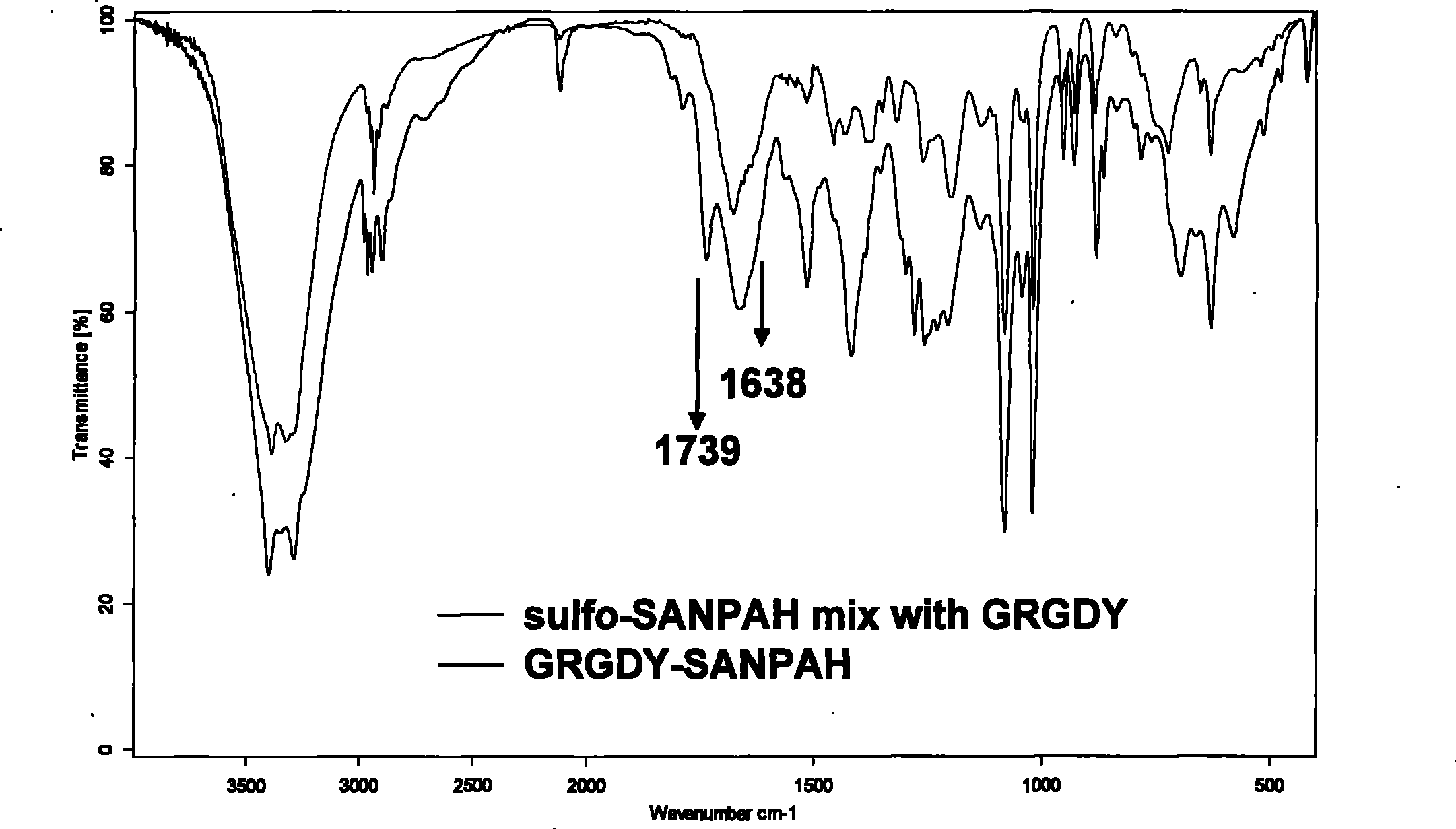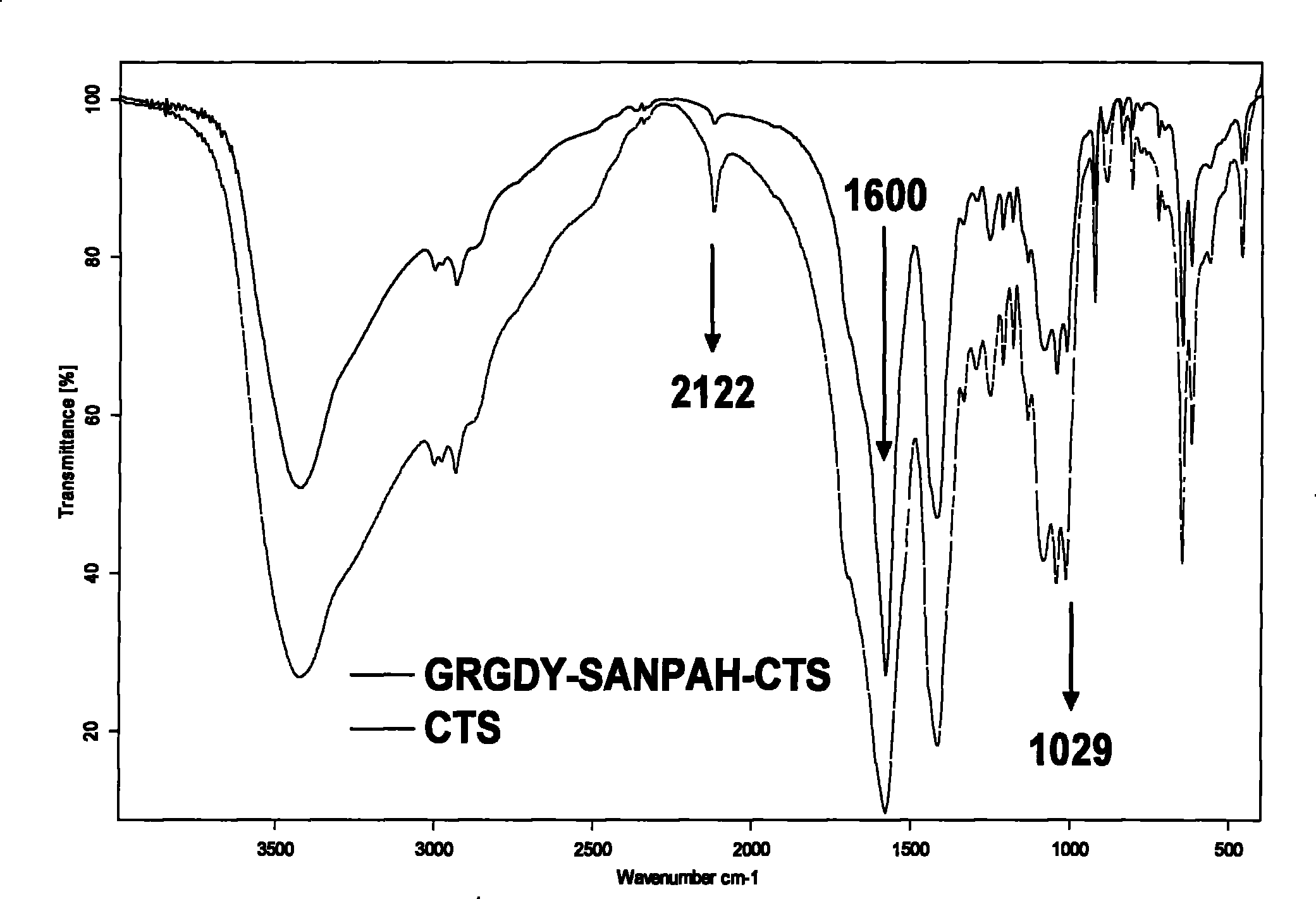Method for photochemical cross-linking cell adhesion peptides on chitosan hydroxyl
A chitosan hydroxyl and adhesion technology, applied in the field of modification of biomedical material chitosan, can solve the problems of difficult amino protection and chemical toxicity during deprotection, and achieve mild reaction conditions, fast reaction rate, steady state effect
- Summary
- Abstract
- Description
- Claims
- Application Information
AI Technical Summary
Problems solved by technology
Method used
Image
Examples
Embodiment 1
[0027]1. At room temperature, dissolve 1 g of chitosan (Mw=148kDa, DD=80%) in 100 mL of aqueous acetic acid with a molar concentration of 0.05 M, adjust the pH of the solution to pH 4.5, and form a transparent 1% (w / v ) chitosan solution;
[0028] 2. Add sulfo-SANPAH and GRGDY to water at a ratio of 1:1 according to the amount of substances. The final concentration of photosensitive cross-linking agent is 2M. GRGDY and sulfo-SANPAH react at room temperature in the dark for 120 minutes to form GRGDY-SANPAH and its untreated The mixed solution of raw materials for the reaction;
[0029] 3. The ratio of sulfo-SANPAH and GRGDY is 1:1 according to the amount of substances, respectively added to water, the final concentration of photosensitive crosslinking agent is 2M, and GRGDY and sulfo-SANPAH are mixed at room temperature in the dark;
[0030] 4. Add chitosan solution to GRGDY-SANPAH and its raw material mixture according to the ratio of photosensitive cross-linking agent to glu...
Embodiment 2
[0035] 1. At room temperature, dissolve 3g of chitosan (Mw=90kDa, DD=90%) in 100mL of aqueous acetic acid with a molar concentration of 0.05M, adjust the pH of the solution to pH4.5, and form a transparent 3% (w / v ) chitosan solution;
[0036] 2. Add sulfo-SANPAH and GRGDY to the same volume of ethanol and water at a ratio of 1:2, and then mix them. The final concentration of photosensitive cross-linking agent is 1mM. React GRGDY and sulfo-SANPAH at room temperature in the dark for 60 minutes. , forming a mixed solution of GRGDY-SANPAH and its unreacted raw materials;
[0037] 3. Measure according to the ratio of photosensitive cross-linking agent and glucosamine residue in chitosan as 1:5, add chitosan solution to the above reaction mixture, mix well, and irradiate with UV for 45 minutes.
[0038] 4. Add the above reaction mixture solution into a dialysis bag with a molecular weight cut-off (MWCO) of 14kDa, and dialyze until the dialyzed aqueous solution cannot detect any ch...
Embodiment 3
[0041] 1. At room temperature, dissolve 1 g of chitosan (Mw=50kDa, DD=80%) in 100 mL of aqueous acetic acid with a molar concentration of 0.1 M, adjust the pH of the solution to pH 6.0, and form a transparent 1% (w / v ) chitosan solution;
[0042] 2. Take by weighing photosensitive crosslinking agent sulfo-SANPAH (according to photosensitive crosslinking agent and chitosan, the ratio of substance amount of glucosamine residue is 1:50 metering), join in the ethanol, add to photosensitive crosslinking agent solution subsequently Add sulfo-SANPAH to GRGDY aqueous solution with a ratio of 1:50 of sulfo-SANPAH to GRGDY, and the final concentration of photosensitive cross-linking agent is 1 μM. React in the dark for 90 minutes at room temperature to form a mixture of GRGDY-SANPAH and unreacted raw materials;
[0043] 3. Measure according to the ratio of photosensitive cross-linking agent and glucosamine residue in chitosan as 1:50, add chitosan solution to the above reaction mixture...
PUM
 Login to View More
Login to View More Abstract
Description
Claims
Application Information
 Login to View More
Login to View More - R&D
- Intellectual Property
- Life Sciences
- Materials
- Tech Scout
- Unparalleled Data Quality
- Higher Quality Content
- 60% Fewer Hallucinations
Browse by: Latest US Patents, China's latest patents, Technical Efficacy Thesaurus, Application Domain, Technology Topic, Popular Technical Reports.
© 2025 PatSnap. All rights reserved.Legal|Privacy policy|Modern Slavery Act Transparency Statement|Sitemap|About US| Contact US: help@patsnap.com



